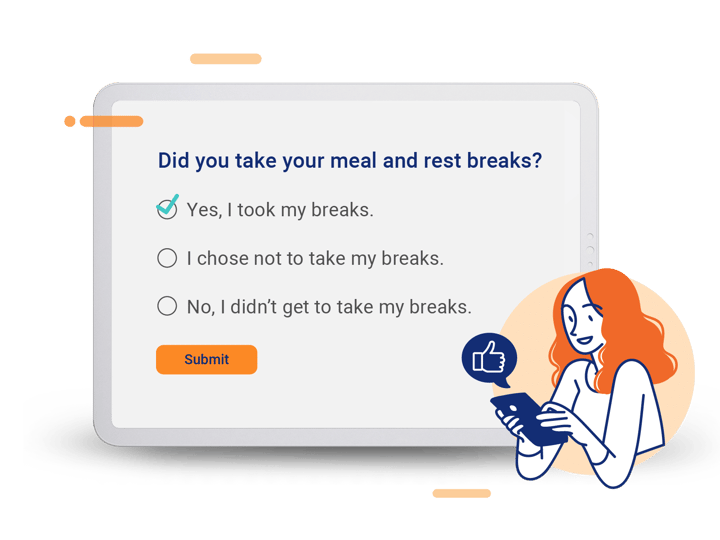
- Home
- Crunchtime Blog
- The Shift Where I Became a District Manager and Turned Chaos into Consistency

The Shift Where I Became a District Manager and Turned Chaos into Consistency
Craig Weiss has decades of experience in the restaurant industry, including 35 years with Domino’s Pizza. Throughout his tenure, he has worked in numerous roles supporting restaurants, from assistant manager to chief operating officer.
The store team looked completely lost.
Ringing phones. Waiting customers. Subpar product.
When I walked into my first store as a newly promoted District Manager, although it seemed like a scene straight out of a movie, I quickly realized I wasn’t in Kansas anymore.
Let me take you through the shift from my perspective.
As I watched employees bump into each other, I constantly heard "We just don't have enough people, we need more," but really we just needed to do better with the people we had already, by working smarter, not harder.
Due to the lack of training, employees moved in unpredictable patterns, constantly referring back to a wall covered with job aids with various instructions scribbled on each one. Order screens flickered urgently, as the frazzled staff navigated a maze of stacked boxes and steaming ovens, drowning in a sea of unfulfilled requests. Orders misplaced, deliveries delayed, and frustration palpable.
The common thread with every issue I encountered that day was blamed on staffing, but really was due to lack of proper training—at no fault of the store team themselves, they were doing the best they could with the resources they were given.
In that moment, I knew I needed to take this chaos and use it to work in our favor, by getting back to the basics and properly training our team. The GM at this store was visibly overwhelmed and stressed, but after some discussion, we agreed on a simple framework—the five steps of on-the-job training—to not only take control over what felt like a messy situation, but more importantly, help our employees be (and feel) more successful—on this shift and moving forward.
The Five Steps of On-the-Job Training
- Create a positive atmosphere
- Preview the task
- Show how the task is done
- Practice and observe
- Provide feedback
(There are many different versions, but these are the five we went with)
Putting the coaching framework into action
Then it was time to put the five steps to work. Before the store opened the next day, we set up some time to train three team members on product-making tasks. I intentionally chose three team members to prove the power and potential of proper training. We trained only one employee of the three employees at a time with the following caveats:
- We started by teaching the first employee without using any of the five steps of training.
- You could say that this employee was ‘thrown to the wolves’ which, unfortunately, isn’t an uncommon scenario in many restaurants. Zero training paired with a ‘just get it done’ mentality.
- The second employee was trained using only two out of the five steps of training.
- This employee was given just two steps—we previewed the task and then VERY quickly showed how it was done.
- The third employee was trained using all five steps of training.
- This employee was given the benefit of the whole process. We took time to ensure that they fully understood the what, the why, and the how.
The task should’ve taken no longer than a total of eight minutes to complete. The results spoke for themselves:
| Trainee | Training Steps Given | Minutes Spent Training |
Minutes to Complete Task |
Total Minutes Spent on Training and Task |
| 1 | 0 out of 5 |
0 |
15 |
15 |
| 2 | 2 out of 5 | 1 | 7 | 8 |
| 3 | 5 out of 5 |
5 |
1 | 6 |
The table shows 15 minutes for the first trainee to complete the task, but in reality, that was when they gave up completely, which is the equivalent of a team member making the decision that it is not a place they want to work. Sound familiar? Ever had a first shift like that?
We invested a whopping 60 seconds to train employee number two. This employee was able to complete the task in 7 minutes, one minute shy of the total amount of time it should have taken to complete. The biggest observation was, that although the task was done, the quality and process suffered to get there, and the trainee was completely satisfied with their work, even though parts of it were incorrect.
The way we trained this employee is, unfortunately, a common and prevalent issue throughout the industry—we give them just enough knowledge to be dangerous, yet we hold them accountable as if they are fully trained. You’ll see this in the form of walls covered with job aids, handwritten notes, and reminders in the back of the restaurant.
Trainee number three completed the task flawlessly, and stress-free. They received all of the proper training they needed, in a comfortable environment. They were taught why the task was important and how they played a role in its success.
Here, we spent more time training the employee than the actual task itself took.
The total time to complete the training and the task (perfectly I might add) was less in the long run—which is why the power of proper training should never be underestimated. The other management team leaders also got much better at training just from watching this exercise. The onus of getting a new team member trained, or an existing team member up to speed on a new task or process should fall on the trainer.
Yup, the hard part falls on the trainer, but the outcome benefits the team member, the customer, and the rest of the team. In other words, train hard, fight easy!
A vision for fully-trained and accountable store teams
Fully trained teams are the ones who stick around longer instead of leaving after a few months, who drive results and ultimately make my job easier as a DM, who turn chaos into consistency, and, dare I say, make it fun.
In contrast, improperly trained teams are the ones who underperform, don’t take responsibility for their own work, negatively affect the rest of the team and profitability, and make the store feel chaotic.
In my experience, training and accountability are partners, not competitors. One cannot be effective without the other.
Here’s why:
- If you hold team members accountable without being trained, they get frustrated and either do things incorrectly, or they quit. Even worse, sometimes they quit and stay anyway (AKA completely check-out mentally).
- On the other hand, if you train team members without holding them accountable, they start to wonder why am I doing this? Without the accountability in place, they tend to start taking shortcuts and eventually, the training is moot.
For me, as a restaurant leader, seeing the smile on someone’s face when they have all the help they need to nail the task perfectly on the first try is priceless. It’s what motivates me to keep strong convictions about training to work smarter, not harder.
Training is a process, not an event.
In time, the store got where it needed to be. Training is not a silver bullet—it's hard, ongoing work, that does pay off in the long run. You might even say, it's kind of like a yellow brick road that helped lead us from chaos to consistency.
The Shift is an industry-focused blog series from contributors who share their inside perspectives on life working in foodservice and restaurants. Interested in sharing your story on The Shift? Email us at hello@crunchtime.com.
Share this post
Related


The Shift: 5 Ways ‘QSR Guy’ Continually Invests in His 500+ Employees

